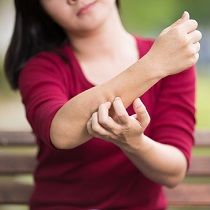News
Article
Itch, Scratching Behavior Most Influential on Quality of Life for Individuals with Prurigo Nodularis
Author(s):
This new qualitative data may be helpful both for patient-centric decision-making for clinicians as well as endpoints in future research on prurigo nodularis.

Itching and the subsequent scratching behavior are linked to a majority of prurigo nodularis (PN) symptoms and exert the most influence on one’s quality of life, according to new findings, and this can help inform endpoint selection in clinical research on PN treatments.1
This data resulted from a new qualitative study assessing 21 adult patients with PN, conducted given recent reports of a lack of substantial qualitative research—including focus group research and interviews, for example—on PN symptoms and patient quality of life.2
This new qualitative study was led by Danielle Rodriguez, PhD, from Evidera in Seattle, Washington. Rodriguez and colleagues felt that expanding upon existing research on the lives of patients with the debilitating neuroimmune skin condition would be invaluable to the field.
“The main objective of this study was to conduct qualitative research to document the burden of illness in PN using direct patient input,” Rodriguez and colleagues wrote. “The study was part of a larger project that also aimed to validate published patient-reported outcome measures using the peak pruritus numerical rating scale (NRS) score, the sleep disturbance NRS score, and Morning Sleep Diary in people with PN.”
Background and Findings
The investigators carried out their qualitative research, and the researchers involved were affiliated with the contract research organization Evidera. The investigators utilized one-on-one telephone discussions with English-speaking adults from the US and in the age range of 18 years or older, with the participants having been diagnosed with PN for at least half a year.
Those recruited by the research team had to have severe pruritus—identified as a peak pruritus NRS score of ≥7—and have moderate-to-severe disturbance of sleep with a sleep disturbance NRS score of ≥4 at the time of their screening. Investigators recruited in the time between September 2020 and March 2021, using patient panels, associations, and social media, and interviews took place in the same time frame.
During the team’s interviews with participants, the team had them describe their most troublesome symptoms as well as the effects the symptoms had on the participants’ lives. The questions specifically asked about itching-related effects.
The investigators also gathered data on participant demographics and medical history, including participants’ self-reported races and ethnicities, with those involved each being given $150 as compensation. For the team to allow for the confidentiality of their research, they utilized unique identifiers and they de-identified, transcribed, and reviewed interviews for accuracy.
The investigators’ coded transcripts of their interviews were given a content analysis through ATLAS.ti software, and they assessed a saturation of concepts to point out when zero new information was found. Additionally, the investigators tailored their training for the study personnel and feedback so as to enhance consistency of the resulting data.
The research team ended up with 21 adult participants that had cases of PN and were interviewed in the study, with those included reporting a mean age of 53.1 years and being 71% female and 86% White. The most commonly noted symptoms of PN were shown to be itch, bleeding/scabbing, pain, lumps/bumps, burning, skin dryness, crust found on patients’ skin, stinging, discoloration, lesions/sores, and raw skin.
When the investigators looked at the symptoms specified as their worst, they found that 88% reported itching as being the most troublesome of the symptoms. PN was shown to have affected these individuals’ life qualities, resulting in disruptions of patients’ sleep, mood, social activities, lives each day, personal relationships, and work or school, with the team finding the one impacting the most was PN’s influence on mood and feelings.
“These findings can be used to guide the selection of end points for assessing patient-relevant outcomes in clinical trials and should help capture treatment benefits that are important to patients with PN,” they wrote. “These findings may also be useful for patient-centric decision-making in clinical practice.”
References
- Rodriguez D, Kwatra SG, Dias-Barbosa C, et al. Patient Perspectives on Living With Severe Prurigo Nodularis. JAMA Dermatol. Published online September 20, 2023. doi:10.1001/jamadermatol.2023.3251.
- Fofana F, Dias-Barbosa C, Rodriguez D, et al. A literature review of patient-reported outcome measures used in assessment of sleep disturbance in atopic dermatitis. Presented at: 29th European Academy of Dermatology and Venereology Virtual Congress; October, 29-31, 2020.





